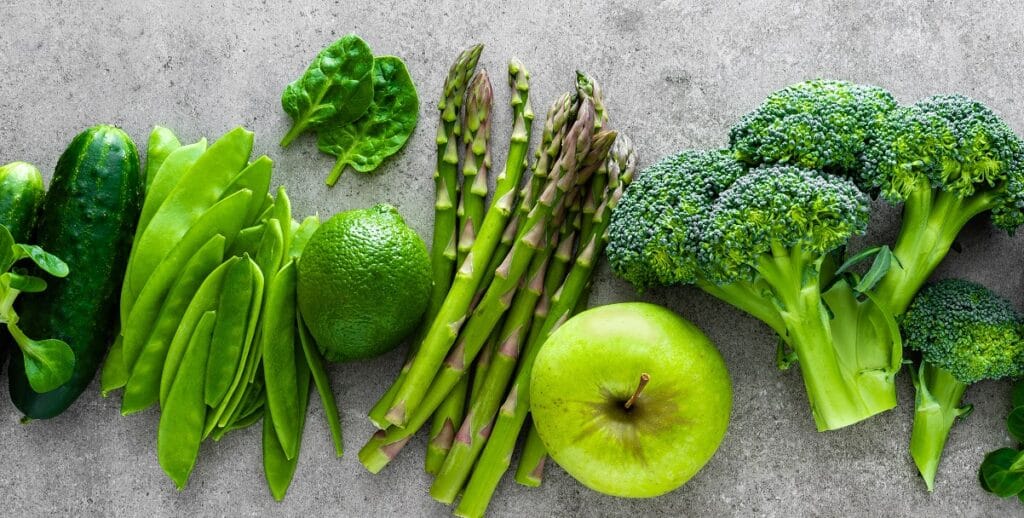The ketogenic diet has gained massive popularity over the past decade for its effectiveness in weight loss, managing blood sugar levels, and improving overall health. However, traditional keto diets often rely heavily on animal-based fats and proteins, which can lead to concerns about sustainability, environmental impact, and overall health. The “Green Keto Diet,” a plant-forward approach to keto that emphasizes plant-based foods while still keeping carbohydrate intake low. This article will delve into everything you need to know about the green keto diet, its benefits, how it differs from traditional keto, what foods to eat, meal planning tips, and more.
What is the Green Keto Diet?
The Green Keto Diet is a variation of the traditional ketogenic diet that emphasizes plant-based, whole foods. It maintains the low-carb, high-fat, and moderate-protein macronutrient ratios of standard keto but focuses more on green vegetables, plant-based fats, and minimally processed ingredients. This approach not only supports ketosis, the metabolic state where your body burns fat for fuel, but also aligns with ethical, environmental, and health-conscious eating practices.
The goal of the Green Keto Diet is to reap the benefits of ketosis—such as weight loss, improved energy levels, and better mental clarity—while consuming more greens and plant-based foods. This diet is ideal for individuals who are health-conscious, environmentally aware, or simply looking to diversify their food intake with more plant-based options.
Benefits of the Green Keto Diet
- Promotes Sustainable Weight Loss Just like the traditional keto diet, the Green Keto Diet can help with weight loss by promoting fat burning and reducing hunger. The inclusion of high-fiber vegetables and plant-based fats can further support weight management by providing satiety and nutrient density, making it easier to stick to your dietary goals.
- Supports Heart Health A plant-based approach to keto can reduce the intake of saturated fats typically found in meat and dairy. Instead, it emphasizes heart-healthy fats from sources like avocados, nuts, seeds, and olive oil, which are rich in monounsaturated and polyunsaturated fats. These fats have been associated with reduced risk of heart disease, improved cholesterol levels, and better blood pressure regulation.
- Reduces Environmental Impact A Green Keto Diet aligns with eco-friendly eating practices. By focusing on plant-based foods, it reduces the environmental footprint associated with meat production, such as greenhouse gas emissions, water usage, and land degradation. This makes it a more sustainable choice for those looking to reduce their ecological impact.
- Improves Gut Health The diet’s emphasis on leafy greens, low-carb vegetables, and plant-based fiber supports a healthy gut microbiome. High-fiber foods promote digestive health, reduce inflammation, and can enhance the absorption of essential nutrients, contributing to overall wellness.
- Balances Blood Sugar Levels Both traditional and green keto diets are known for their ability to stabilize blood sugar levels, making them beneficial for individuals with insulin resistance or type 2 diabetes. By limiting high-glycemic foods and focusing on low-carb vegetables and healthy fats, the Green Keto Diet can help maintain steady blood glucose levels.
- Boosts Antioxidant Intake A plant-based keto diet is rich in antioxidants from vegetables, nuts, seeds, and fruits. These antioxidants help fight oxidative stress, reduce inflammation, and protect against chronic diseases, including cancer and heart disease.
How Does the Green Keto Diet Differ from Traditional Keto?
While both the Green Keto Diet and the traditional ketogenic diet share the same macronutrient goals—low carb, high fat, moderate protein—the Green Keto Diet places a greater emphasis on plant-based foods. Here’s a closer look at the key differences:
- Focus on Plant-Based Fats Traditional keto often relies on animal fats such as butter, cheese, and fatty cuts of meat. In contrast, the Green Keto Diet prioritizes plant-based fats like olive oil, coconut oil, avocados, nuts, and seeds, which are rich in essential fatty acids and have additional health benefits.
- Higher Vegetable Intake While both diets encourage low-carb vegetables, the Green Keto Diet emphasizes a larger variety and quantity of greens, cruciferous vegetables, and other low-carb, nutrient-dense plants. This increases fiber intake and provides a broader spectrum of vitamins, minerals, and antioxidants.
- Reduced Animal Protein Instead of focusing on animal-based proteins, the Green Keto Diet incorporates more plant-based protein sources, such as tofu, tempeh, nuts, seeds, and leafy greens. This shift can reduce the intake of cholesterol and saturated fats while providing adequate protein levels.
- Elimination of Processed Foods The Green Keto Diet discourages processed foods, even if they fit within keto macros. Instead, it promotes whole, unprocessed foods, making it a cleaner and more nutrient-dense option.
- More Sustainable and Ethical Choices By reducing or eliminating animal products, the Green Keto Diet aligns with ethical considerations related to animal welfare and environmental sustainability. This makes it an attractive option for vegetarians, vegans, or anyone concerned about the environmental impact of their food choices.
YOU MAY ALSO LIKE: Green Vegetables for Weight Loss
Key Components of the Green Keto Diet
To successfully follow the Green Keto Diet, it’s important to focus on certain food groups while avoiding others. Here’s a breakdown of the key components:
Foods to Include
- Low-Carb Vegetables
- Leafy greens: Spinach, kale, arugula, Swiss chard
- Cruciferous vegetables: Broccoli, cauliflower, Brussels sprouts
- Other low-carb options: Zucchini, bell peppers, asparagus
- Plant-Based Fats
- Avocados and avocado oil
- Olive oil
- Coconut oil and coconut milk
- Nuts and seeds: Almonds, walnuts, chia seeds, flaxseeds
- Plant-Based Proteins
- Tofu and tempeh
- Edamame
- Hemp seeds and hemp protein powder
- Plant-based protein powders (choose low-carb options)
- Low-Glycemic Fruits
- Berries: Strawberries, raspberries, blackberries
- Small amounts of other low-sugar fruits: Avocado, olives, tomatoes
- Herbs and Spices
- Fresh herbs: Basil, parsley, cilantro
- Spices: Turmeric, cinnamon, cumin, garlic
- Dairy Alternatives
- Unsweetened almond milk
- Coconut yogurt (unsweetened)
- Nutritional yeast (for a cheesy flavor)
Foods to Avoid
- High-Carb Vegetables and Fruits
- Starchy vegetables: Potatoes, sweet potatoes, corn
- High-sugar fruits: Bananas, grapes, apples
- Animal-Based Fats and Proteins
- Red meat, poultry, fish
- Butter, cheese, cream
- Processed and Refined Foods
- Packaged snacks, even if labeled as keto-friendly
- Refined oils and trans fats
- Sugary Foods and Beverages
- Sugary drinks: Soda, fruit juices
- Sweets: Candy, baked goods, ice cream
How to Get Started with the Green Keto Diet
Step 1: Calculate Your Macros
To start the Green Keto Diet, you need to calculate your daily macronutrient needs. The typical keto macro ratio is:
- 70-75% of calories from fats
- 20-25% of calories from protein
- 5-10% of calories from carbohydrates
You can use a keto calculator online to determine the exact amounts based on your age, gender, weight, activity level, and goals.
Step 2: Meal Planning and Preparation
Planning your meals ahead of time is key to staying on track with the Green Keto Diet. Focus on incorporating a variety of low-carb vegetables, plant-based fats, and proteins into your meals. Here’s a sample meal plan:
Breakfast: Avocado smoothie with spinach, unsweetened almond milk, chia seeds, and a scoop of plant-based protein powder.
Lunch: Salad with mixed greens, cucumber, avocado, cherry tomatoes, hemp seeds, and olive oil dressing.
Snack: A handful of almonds or a small serving of coconut yogurt with berries.
Dinner: Stir-fry with tofu, broccoli, bell peppers, zucchini, and coconut oil.
Dessert: Dark chocolate (70% cocoa or higher) or a keto-friendly berry chia pudding.
Step 3: Monitor Your Progress
Keep track of your food intake, energy levels, weight, and any changes in your overall health. Apps like MyFitnessPal or Carb Manager can help you log your meals and ensure you’re meeting your macro goals. Regularly check your ketone levels using urine strips, breath meters, or blood ketone meters to confirm you’re in ketosis.
Common Challenges and Tips for Success
1. Getting Enough Protein:
Ensure you’re consuming enough plant-based proteins, such as tofu, tempeh, hemp seeds, and low-carb protein powders. Consider including a protein source in every meal to meet your needs.
2. Avoiding Hidden Carbs:
Read labels carefully, especially on packaged plant-based products, to avoid hidden sugars and carbs that can kick you out of ketosis.
3. Managing Cravings:
If you find yourself craving carbs, increase your intake of healthy fats and fiber. Avocados, nuts, seeds, and coconut oil are satiating options that can help curb cravings.
4. Ensuring Adequate Nutrient Intake:
The Green Keto Diet can sometimes be low in certain nutrients like iron, B12, and calcium if not well-planned. Consider a multivitamin or specific supplements, especially if you’re following a strictly vegan version.
5. Staying Hydrated and Maintaining Electrolytes:
Low-carb diets can lead to increased water loss, so it’s important to stay hydrated and replenish electrolytes. Drink plenty of water and include sources of sodium, potassium, and magnesium in your diet.
Conclusion
The Green Keto Diet offers a plant-forward approach to the traditional ketogenic diet, providing the same benefits of ketosis while aligning with sustainable, ethical, and health-conscious eating practices. By focusing on low-carb vegetables, plant-based fats, and proteins, this diet supports weight loss, heart health, and improved energy levels, all while reducing environmental impact. Whether you’re new to keto or looking to make your current diet greener, the Green Keto Diet is a versatile and rewarding option that can fit a variety of lifestyles.
References
- Ludwig, D. S., & Ebbeling, C. B. (2018). The Carbohydrate-Insulin Model of Obesity: Beyond “Calories In, Calories Out.” JAMA Internal Medicine, 178(8), 1098–1103.
- Hallberg, S. J., Gershuni, V. M., Hazbun, T. L., & Athinarayanan, S. J. (2019). Reversing Type 2 Diabetes: A Narrative Review of the Evidence. Nutrients, 11(4), 766.
- Clark, M. A., Springmann, M., Hill, J., & Tilman, D. (2019). Multiple Health and Environmental Impacts of Foods. Proceedings of the National Academy of Sciences, 116(46), 23357–23362.
- Moreno, B., Bellido, D., Valverde, Á. M., & de Córdoba, S. R. (2021). Ketogenic Diet: From Physiology to Clinical Practice. Clinical Nutrition ESPEN, 45, 6-17.


